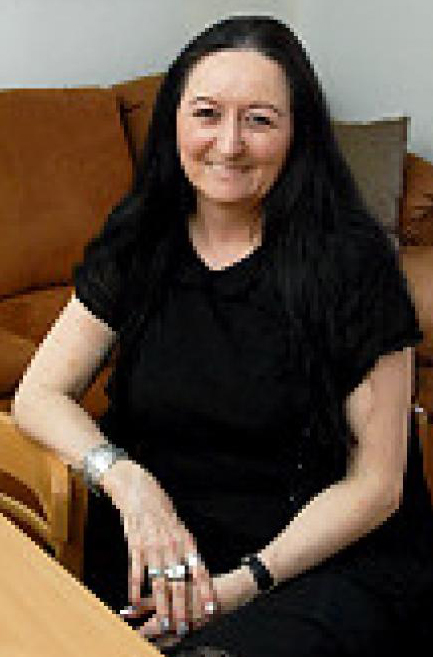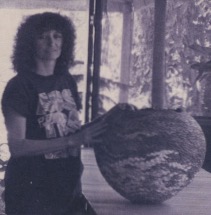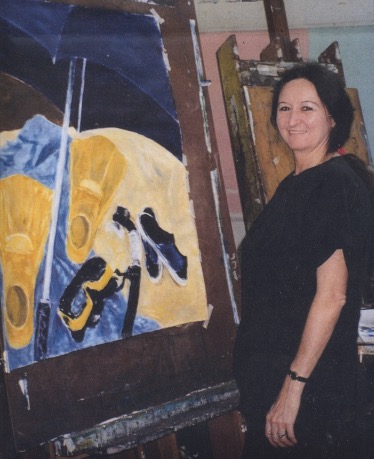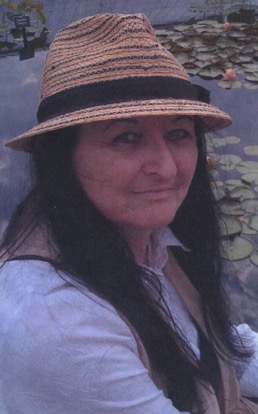Eva Orban, Visual Artist
December 16, 1951 — January 9, 2016

Eva Orban is an artist whose work is defined by the three continents on which she lived.
She was born in 1951, in the landlocked country of Hungary, in the town of Kormend, near the Austrian border. She and her family lived in a large school located on the expansive grounds of a castle, as her father was the school’s caretaker and gardener. The parks and the nearby River Raba were her playground. This early exposure to beautiful outdoor surroundings led to her life-long love and reverence for nature. Rivers and lakes (and later, oceans) have been a particular influence in her artwork. She always felt an urge to travel. Her need to explore the unknown made her relocate after high school to a larger, historic border town, then to Budapest, and finally, at the age of 26, to the beautiful, vast continent of Australia.
In rural South Australia near the River Murray, she spent her first few years growing wine grapes and citrus fruits. She then took two years for extensive world travel, ultimately choosing to settle in North Queensland. Here, in the early 1980s, finally feeling she’d arrived home — in the lush tropics surrounded by the turquoise water of the Coral Sea, sheltered by the Great Barrier Reef and the 74 scenic, mostly uninhabited islands of The Whitsundays — she began serious work in ceramics.

Despite a lack of formal training in this field, Orban’s unique work made it’s way to numerous public collections, including the National Gallery of Australia. Orban’s tireless dedication to her art/craft won her numerous ceramic competitions and she participated in many art exhibitions, including “Out of The North,” a 2-year national touring exhibition featuring her large-scale, colorful, hand-built ceramic forms. Orban developed the unique technique of adding color to raw clay before working it, where surface texture and color became an integral part of the form from the first touch, leaving no chance for later correction or afterthought. Colors and textures were embedded in each piece.
Since she constructed these large, hand-built forms using small pieces of clay, it made sense to her to add colors, and sometimes other texturing materials to each tiny module. Even her fingerprints often bear witness on the surface of these tediously created forms.
For these earlier, textured ceramic works, she used laborious wood firing exclusively, where ashes added further unpredictable magic to her pieces. Until the early 1990s, she continued with large clay pieces, often moving up vertically from the previously spherical shapes. She eventually worked smoother and simply in blues, greens and white, using gas firing for a more crisp, clear finish. During a brief absence in 1996, she discovered that her kiln had been given away, and took it as a sign that she should switch to painting.

Though Orban was somewhat isolated in North Queensland, she dove into painting through all available means. She went to Brisbane to study at Queensland College of Art, Griffith University. Halfway through her bachelor’s degree, she took advantage of the international exchange program to study for a year at a New York State college in Oswego, in upstate NY, which she hoped would bring her closer to the NY city art world.
She planned to remain in NY only a year before returning to Queensland to finish her BA, but then was granted an opportunity to stay in America an additional year for employment. She worked with a French tapestry producer who offered sponsorship to remain even longer, allowing her to fully embrace the cultural climate of New York City.
Since 2000, she lived, worked, and created and investigated art while simultaneously navigating the intricate, ungainly NY metropolis, where inventiveness was often a requirement for survival. Art sometimes was sidelined due to financial concerns.
It took some time to establish her basic financial stability in NYC (see The NY Daily News article about Eva Orban). Orban built a home in NY, and became a permanent resident of the U.S.--though she retained her Australian citizenship and her work continued to be inspired by her years there.
Since her switch to painting, she combined different media in her works, often using computer graphics in her process. She developed large-scale oil and mixed-media pieces by transforming images from her watercolors, the ‘Rapture’ series, and from digital montages. Her work reflected the frenetic hubbub of life today. She felt art no longer called for meditative observation of a single image—so she grouped images in a shattered manner, in synch with the rapid-paced digital age.
Besides painting, Orban’s work involved surface design mostly inspired by The New York Botanical Garden (which she regards as her ‘backyard’) and her two decades in Australia’s tropics. Orban’s goal was to create a body of artwork for a major solo exhibition in New York. She dreamed of showing simultaneously in Hungary and Australia. All the places of her life contributed to who she is; it was her intention to unite them in her art, as they were merged in her.
Unfortunately, her plans were cut short by a battle with cancer which ended her life at the age of 64 in January of 2016. She will be remembered by family, friends, and colleagues for her playful spirit, her talent and her enormous heart.
